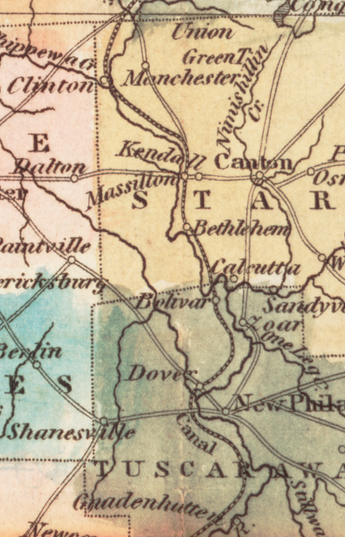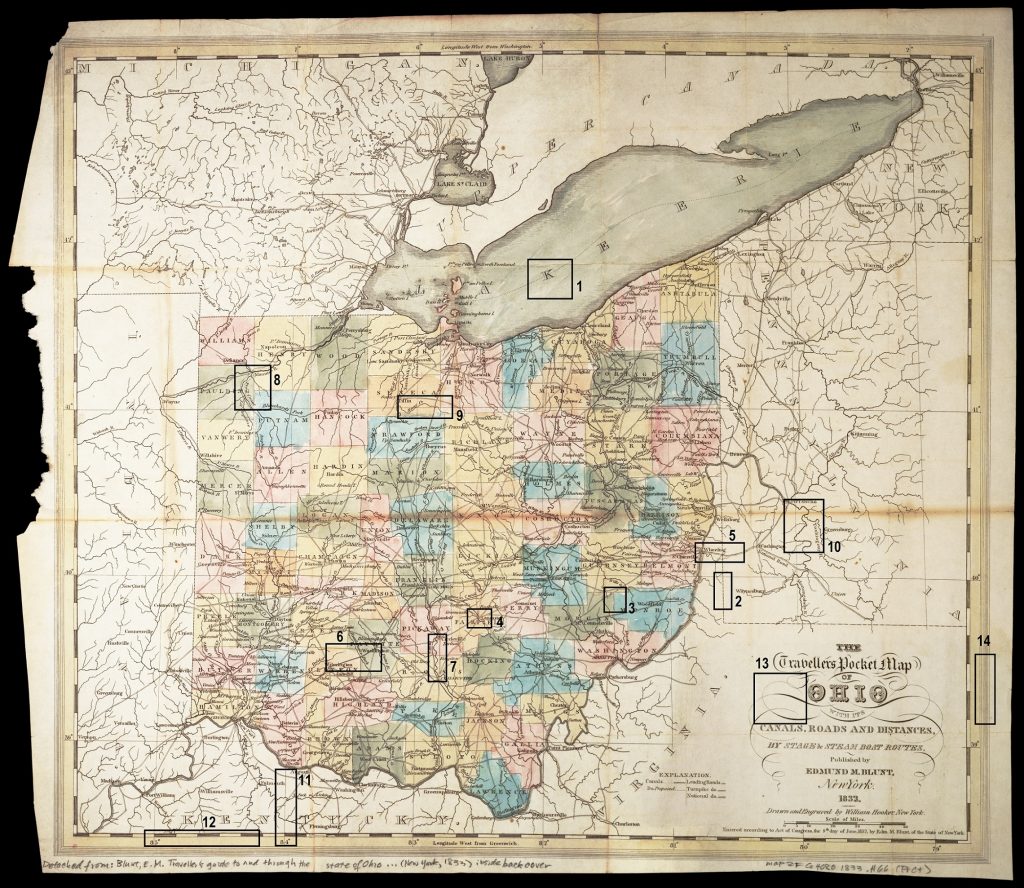Curriculum Connections: Geography, Maps, Visual Literacy
Materials – Available for Download in the Downloads Tab:
- A copy of the Skills Lesson
Look at the map “The Travellers Pocket Map of Ohio.”

Without looking too closely, you can probably understand that the colors are helping you see the state’s counties. You can also recognize a light coloring to show the water in Lake Erie. But what about all the different lines in the map?

When you look at a detail of part of Ohio, it can seem like a confusing mess of lines with different designs, different weights, and different patterns. By untangling all these different kinds of lines, we can understand how this map works and, in turn, how its elements work together to tell a story about Ohio.
First, let’s identify the different kinds of lines on the map:
- Dotted line in Lake Erie
- Thicker dotted lines
- Dotted lines in Ohio along borders of color
- Double lines emanating from cities in Ohio
- Double lines with a serrated line
- Double lines that are filled in
- Double lines with cross lines between them
- Single dotted lines that seem to follow double lines
- Squiggly single lines throughout the map
- Darker squiggly single lines throughout the map
- Vertical and horizontal lines connecting the map’s edges
- Double lines around the edge of the map with alternating black and white sections
- Curling lines around the title
- Lines along the border of the map

That’s a lot of different lines!
To understand how they all work, we can start to categorize them by function.
Lines that Show Borders
The first three types of lines in the list show political boundaries, between the US and Canada, between US states, and between counties in Ohio.



Lines that Show Infrastructure
The different kinds of double lines throughout Ohio seem to connect different places. Because of that observation, we might infer that they are roads. But what kind? Knowing we might be confused, the mapmaker has provided a legend! The legend explains that three types of double lines are different sizes of roads. The other double line shows canals. The abbreviation “do” here stands for “ditto,” a term which indicates that a word or figure is repeated in a list.





And this particular dotted line (#8) shows canals that have been proposed but not yet built. In fact, with one example of this line on the map, we can also see that it is labeled proposed canal (abbreviated “pro canal”).
Lines that Show Water
Although they are not identified in the legend, the squiggly lines throughout the map have labels that identify them as water systems, with abbreviations like Cr. for creek, and R. for river.
![Detail of a map showing a dark squiggly line representing a river. The line is marked "Honey Cr. [Creek]."](https://dcc.newberry.org/wp-content/uploads/2023/09/Image9_River.png)

Lines that Show a Grid
Criss-crossing the entire map are solid lines that emanate from numbers along the edges. Sometimes these lines disappear and reappear. These lines make the grid of longitude and latitude, which give a mathematical basis to locations on the map. Likewise, the double lines with alternating black and white sections can help us follow fraction of degrees between the lines of longitude and latitude along all the map’s edges.


Lines that Decorate
These lines do not communicate any particular information. They instead add style to the map. The loops and curls around the title and the border of nine lines around the very edge of the map draw our eyes to the action of the map and add depth to the image.


Questions for Discussion
Looking carefully at how different kinds of lines work on this map helps us understand the complexity that goes into designing and reading maps. It can be easy to see a map like this as a simple document that just shows things as they are. But, in fact, it is full of choices that the mapmakers have made to prioritize certain features of this landscape and to downplay others. These choices make some things easy to find and other things hard to see; in other cases, some are totally absent.
As you analyze a map and start to piece together how all the different elements of the map are working together?, you will be able to make your own arguments about how and why a map is telling its story. Consider, for instance, the following questions:
- What aspects of the US does this map call the most attention to? What does the document prioritize?
- What kind of story is this map telling? Who is left out of that story? What sorts of things are not included?
- Do the lines on the map support your argument about the story this map is telling? Besides the lines, what other elements of the map support your argument about the story this map is telling?
Try It Yourself
Using this map as an example, try decoding the lines on these maps yourself:
- H.V. Poor, “Map of All the Railroads in the United States in Operation and Progress” (1854)
- I. Covens et C. Mortier, “Le Royaume de France divise en toutes ses provinces comprises sous douze gouvernements generaux…” (1725)
- “The National System of Interstate and Defense Highways” (1964)
- Edmond Halley, “A New and Correct Chart Shewing the Variations of the Compass in the Western & Southern Oceans” (1732)
Words to Know
Ditto | word used in lists to indicate that a word or figure repeats
Legend | a table on the side of a map that explains the meanings of symbols used in the map
Explore the lines in “The Traveller’s Pocket Map of Ohio” below.
Download the following materials below:
- A copy of the Skills Lesson



